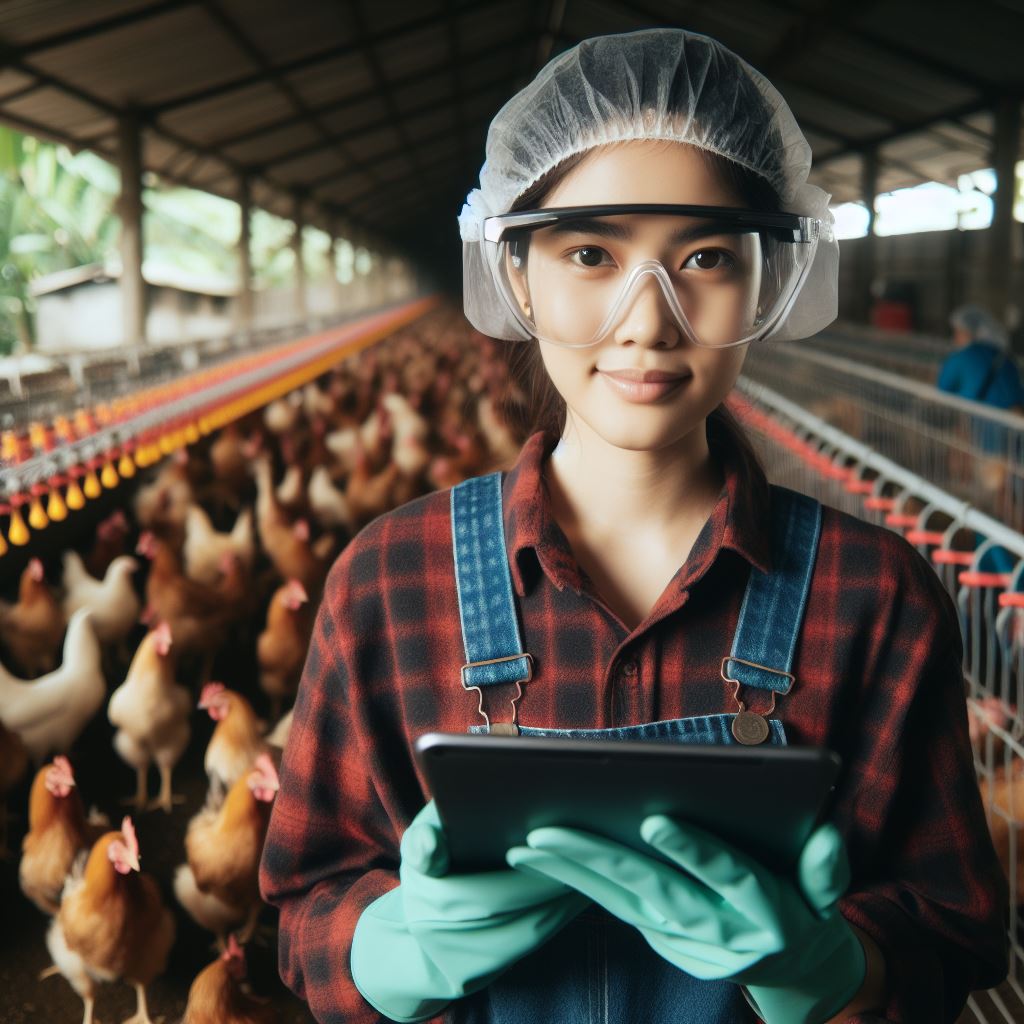Biosecurity: A Poultry Farmer’s Tale
Last Updated on March 1, 2024
Introduction
Poultry Farmer Biosecurity, biosecurity is a crucial aspect of poultry farming, aimed at preventing the entry and spread of diseases.
It involves implementing strict protocols and measures to protect the birds from various pathogens that can cause significant harm.
Poultry farmers understand the importance of biosecurity as it not only ensures the overall health and well-being of the flock but also safeguards the industry’s profitability.
Preventing disease outbreak is vital in poultry farming as it can lead to massive economic losses and impact food security.
This blog post will delve into the experiences of a poultry farmer who has dedicated substantial time and resources to biosecurity measures.
Their firsthand account will shed light on the challenges they encounter on a daily basis and the effectiveness of different protocols.
The farmer’s experience will provide valuable insights into the practical implementation of biosecurity measures, highlighting the significance of following strict guidelines and constantly adapting to new threats.
Through this exploration, readers will gain a deeper understanding of the critical role biosecurity plays in poultry farming and the importance of continuous vigilance in safeguarding the health of poultry flocks.
The Poultry Farmer’s Background
Brief introduction to the poultry farmer
The poultry farmer, John Smith, is a passionate individual dedicated to raising healthy chickens.
Growing up in a small rural town, he developed a deep love and understanding for farming practices.
Driven by his passion, he decided to specialize in poultry farming and embarked on a lifelong commitment.
Number of years engaged in poultry farming
For over two decades, John Smith has successfully managed his poultry farm.
His experience in poultry farming spans more than 20 years, making him a seasoned professional.
Throughout these years, he has faced various challenges, but his determination and expertise have enabled him to thrive.
Importance of biosecurity in the farmer’s operations
Biosecurity plays a vital role in ensuring the overall health and productivity of John Smith’s poultry farm.
By implementing strict biosecurity measures, he aims to prevent the spread of diseases among his chickens.
This not only protects his flock but also helps maintain the integrity of the entire poultry industry.
Strict control of farm access
John Smith understands the significance of limiting unnecessary access to his poultry farm.
He has implemented controlled entry points, requiring visitors to go through a thorough sanitization process.
This prevents the introduction of potential pathogens and reduces the risk of disease transmission.
Regular monitoring and testing
Regular monitoring and testing are crucial aspects of John Smith’s biosecurity protocols.
He regularly conducts health checks on his chickens and ensures that proper laboratory testing is carried out.
This proactive approach allows him to promptly detect and address any health issues, preventing them from escalating.
Strict sanitation practices
Maintaining cleanliness is a top priority for John Smith’s poultry farm.
He keeps the farm’s infrastructure clean and regularly disinfects all equipment, vehicles, and tools used on the premises.
This ensures a hygienic environment for the chickens, minimizing the risks associated with bacterial contamination.
Disease prevention through vaccination
Vaccination is an essential part of John Smith’s biosecurity plan.
He works closely with veterinarians to develop an appropriate vaccination schedule for his flock.
By vaccinating his chickens against common diseases, he can significantly reduce the risk of outbreaks and protect their health.
Employee education and training
John Smith believes in the importance of educating his employees about biosecurity practices.
He conducts regular training sessions to ensure that everyone understands and follows the established protocols.
This empowers his team to actively contribute to maintaining a secure and disease-free environment for the chickens.
Collaboration with industry stakeholders
Recognizing the interconnectedness of the poultry industry, John Smith actively collaborates with other stakeholders.
He participates in industry conferences and engages in discussions to stay updated on the latest biosecurity advancements.
By sharing knowledge and experiences, he contributes to the collective efforts of promoting biosecurity throughout the poultry sector.
In fact, John Smith’s extensive background in poultry farming and his commitment to biosecurity are key factors in the success of his operations.
By implementing strict measures, he ensures the health and welfare of his chickens while contributing to the overall biosecurity of the poultry industry.
Understanding Biosecurity
Definition of biosecurity in the context of poultry farming
In the context of poultry farming, biosecurity refers to a set of practices designed to prevent the introduction and spread of diseases among poultry.
Objectives of biosecurity measures
- Protecting the health and welfare of poultry by preventing diseases from entering the farm.
- Minimizing the risk of disease transmission within the farm and to other farms.
- Safeguarding the overall productivity and profitability of the poultry farming operation.
- Maintaining consumer confidence in the safety and quality of poultry products.
Categories of biosecurity practices
Internal biosecurity measures
Internal biosecurity measures focus on preventing the spread of diseases within the poultry farm itself.
- Implementing strict hygiene practices, such as regular cleaning and disinfection of poultry houses and equipment.
- Adopting proper waste management strategies to limit the buildup of pathogens.
- Controlling access to poultry houses to ensure only authorized personnel enter the premises.
- Implementing strict separation and isolation protocols for sick or infected birds.
External biosecurity measures
External biosecurity measures aim to prevent the introduction of diseases from outside sources into the poultry farm.
- Restricting the movement of people, vehicles, and equipment onto the farm.
- Implementing a secure perimeter fence and using biosecurity signage to raise awareness of the farm’s biosecurity protocols.
- Using dedicated farm clothing, footwear, and personal protective equipment (PPE) to limit disease transmission.
- Ensuring the proper management of farm visitors and maintaining visitor logs for traceability.
- Monitoring and controlling wildlife and other potential disease carriers, such as rodents and insects, in the vicinity of the farm.
In short, biosecurity is crucial in poultry farming to protect the health and well-being of the birds, maintain productivity and profitability, and ensure the safety of poultry products for consumers.
By implementing internal and external biosecurity measures, farmers can effectively reduce the risk of disease introduction and spread, safeguarding their poultry operations in an ever-changing disease landscape.
Read: Detroit’s Green Makeover: Urban Farm Success
Biosecurity Measures Implemented by the Farmer
Description of the poultry farmer’s farm layout
The poultry farmer’s farm is strategically designed to ensure maximum biosecurity and prevent disease spread.
The farm consists of different sections, including:
- Hatchery: A separate building where eggs are incubated and hatched.
- Brooder houses: These provide a warm and controlled environment for young chicks until they are ready to be transferred to grow-out houses.
- Grow-out houses: These houses accommodate the growing birds until they reach market weight.
- Processing facility: A dedicated area where the birds are slaughtered, processed, and packed for sale.
Internal biosecurity measures
To maintain a healthy environment for the birds, the farmer implements strict biosecurity measures inside the farm, which include:
- Disease testing protocols: Regular testing of birds is conducted to detect any potential diseases early on. This helps in taking appropriate measures to prevent their spread.
- Strict biosecurity protocols for employees and visitors: Farm employees and visitors are required to follow strict hygiene and sanitation practices. They must wear protective clothing, including disposable coveralls, boots, and headgear.
- Cleaning and disinfection procedures: Thorough cleaning and disinfection of all equipment, housing, and surrounding areas are performed regularly. This helps eliminate any potential disease-carrying pathogens.
External biosecurity measures
The farmer also implements various external biosecurity measures to prevent disease introduction from outside sources, which include:
- Fencing and security measures: The farm is securely fenced and equipped with surveillance cameras to prevent unauthorized entry by humans or animals that may carry diseases.
- Restricted access to the farm: Only essential personnel and authorized visitors are allowed entry. They need to follow strict biosecurity protocols, such as foot baths, disinfection, and changing clothing.
- Pest control strategies: The farmer adopts effective pest control strategies to prevent pests, including rodents and insects, from entering the farm. Pest control measures ensure the birds are not exposed to disease vectors.
Implementing these biosecurity measures plays a crucial role in protecting the health and well-being of poultry.
By maintaining a controlled environment and preventing disease introduction, the farmer ensures the production of safe and high-quality poultry products for consumers.
Biosecurity measures should never be taken lightly, as disease outbreaks can have devastating consequences for both the poultry industry and human health.
The farmer’s commitment to biosecurity demonstrates their responsibility and dedication to safeguarding their birds and the overall industry.
As consumers, it is essential for us to support poultry farmers who prioritize biosecurity.
By choosing poultry products from farms that follow strict biosecurity protocols, we contribute to better food safety and help prevent disease transmission.
Let’s appreciate the efforts made by farmers in maintaining biosecurity for the sake of our health and well-being.
Read: Philly’s Foodscapes: Urban Farming Upsurge

Biosecurity Challenges Faced by the Farmer
Introduction to Common Biosecurity Threats
Threats to biosecurity encompass risks posed by biological agents, including pathogens, pests, and diseases, to various organisms.
In agriculture, common biosecurity threats include outbreaks of contagious diseases among livestock or crops, invasive species that can disrupt ecosystems and agricultural production, and the spread of antibiotic-resistant bacteria.
These threats can have significant economic, environmental, and public health implications, highlighting the importance of implementing robust biosecurity measures to prevent and mitigate their impact.
Specific Challenges Faced by the Farmer
Poultry farmers encounter various challenges in maintaining a high level of biosecurity on their farms.
These challenges include:
These challenges require farmers to implement proactive measures to mitigate risks and protect the health of their flocks.
1. Disease Outbreaks in Neighboring Farms
Outbreaks in neighboring farms are a constant threat, requiring farmers to monitor disease reports and collaborate with local authorities.
They should also establish strict protocols for farm access, visitors, and equipment movement.
2. Contamination Risks During Transportation
To prevent contamination during transportation, farmers should thoroughly clean and disinfect vehicles, regularly inspecting and maintaining them.
Stringent procedures for farm personnel upon arrival following transportation, such as adhering to thorough hand hygiene and changing attire, must be observed.
3. Wildlife Intrusion and Potential Disease Transmission
To prevent wildlife intrusion, farmers should install effective barriers such as fences or nets.
Regular inspections and repairs ensure their effectiveness.
Additionally, farmers should discourage bird feeding stations and keep poultry houses and feed storage areas clean to avoid attracting wildlife.
By addressing these specific challenges, farmers can minimize biosecurity risks and protect their flocks from disease outbreaks.
Implementing proactive measures, strict protocols, and continuous monitoring is crucial in achieving optimal biosecurity levels on poultry farms.
Read: SF’s Urban Farming Scene: A Startup Story
Discover More: Organic Dreams: One Acre, Big Impact
Mitigating Biosecurity Risks
Early disease detection and preventive measures
Maintaining the highest level of biosecurity on a poultry farm is crucial to protect the health and well-being of the flock.
By implementing early disease detection and preventive measures, such as regular health monitoring programs, inspections, and surveillance systems, farmers can quickly identify any potential disease outbreaks and take immediate action.
Adhering to a strict vaccination schedule is also essential in safeguarding the poultry from common diseases.
Regular training and education for employees
Regular training and education for employees play a vital role in ensuring that all farm personnel understand and follow biosecurity protocols.
By providing comprehensive training and conducting regular refresher courses, farmers empower their employees to actively contribute to disease prevention and control efforts.
Train staff members to recognize early indications of poultry diseases and motivate them to promptly report any suspected biosecurity hazards.
Partnerships with veterinarians and industry experts
Establishing strong partnerships with veterinarians and industry experts is another important aspect of mitigating biosecurity risks.
Local veterinarians can provide regular health check-ups and expert advice on implementing effective biosecurity measures.
Collaborating with industry experts enables farmers to stay updated on the latest advancements and best practices, ensuring their biosecurity protocols are state-of-the-art.
Farmers should engage in knowledge-sharing sessions with these experts to further enhance their biosecurity practices.
Collaboration with neighboring farmers for disease control
Collaboration with neighboring farmers is also crucial in disease control.
Open communication and information exchange on disease outbreaks allow farmers to implement coordinated measures and minimize the risk of contagion.
Establishing a network for quick dissemination of information and emergency response planning is critical in tackling biosecurity risks together.
Joint vaccination campaigns can enhance the overall health of the region’s poultry population, and sharing experiences and lessons learned can collectively improve biosecurity practices.
Mitigating biosecurity risks requires a comprehensive approach that incorporates early disease detection, employee education, partnerships with veterinarians and industry experts, and collaboration with neighboring farmers.
Implementing these measures ensures the highest level of biosecurity on poultry farms, protecting the health and productivity of the flock.
Read: Miami’s Urban Farm Wave: A Tropical Tale
You Might Also Like: Climate Smart Farming: Adapting with Tech
Case Study: Biosecurity Success Story
Narration of a specific incident where biosecurity measures proved effective
- In a small poultry farm, a deadly outbreak of avian influenza was successfully prevented.
- The farm had strict biosecurity protocols in place to ensure the health and safety of their flock.
- One day, a neighboring farm reported an outbreak of avian influenza, causing panic among poultry farmers in the area.
- The farmer immediately activated their biosecurity measures, including restricted access, disinfection points, and isolation areas.
- All workers had to undergo thorough disinfection procedures and change into farm-specific clothing and footwear.
- Visitors were strictly prohibited, and all equipment was thoroughly cleaned and disinfected.
- The farmer’s vigilance and commitment to biosecurity played a crucial role in preventing the disease from entering their farm.
The incident was considered a success
- The incident was considered a success because the farm managed to avoid any outbreak of avian influenza.
- The strict biosecurity measures acted as a barrier, preventing the disease from entering the farm.
- The farmer’s quick response and adherence to protocols ensured the safety of their poultry.
- The incident also highlighted the importance of proactive biosecurity measures in preventing disease spread.
Lessons learned from the case study
- Biosecurity protocols should be implemented and strictly followed to prevent disease outbreaks.
- Restricted access, disinfection procedures, and isolation areas are effective in minimizing disease transmission.
- Regular training sessions for farm workers on biosecurity measures can enhance their understanding and compliance.
- Proactive surveillance and regular health monitoring of the flock can help in early detection of any potential diseases.
- Communication and coordination with neighboring farms are crucial to prevent disease spread.
- Constant evaluation and improvement of biosecurity protocols based on new research and advancements are essential.
The specific incident narrated in this case study emphasizes the importance of biosecurity measures in ensuring the health and safety of poultry farms.
By following strict protocols, the farmer successfully averted the avian influenza outbreak, proving the effectiveness of their biosecurity measures.
This success story imparts valuable lessons, highlighting the importance of proactive surveillance, consistent training, and ongoing evaluation of biosecurity protocols.
Implementing these lessons can help poultry farmers across the industry prevent disease outbreaks and protect their flocks.
Conclusion
Anticipated changes in biosecurity practices
In the ever-evolving landscape of biosecurity, anticipatory measures are crucial.
We anticipate shifts in pathogen strains, environmental factors, and even human behaviors that may pose new risks to our flocks.
As such, we must remain agile in our approach, ready to adjust protocols in response to emerging threats.
By staying proactive, we can stay one step ahead of potential biosecurity breaches, ensuring the health and safety of our poultry.
Importance of continuous adaptation and improvement
The essence of effective biosecurity lies in its ability to adapt and evolve.
A static approach is simply not enough to combat the dynamic nature of pathogens and environmental stressors.
Continuous evaluation and improvement are essential to stay abreast of changing circumstances.
By actively seeking out areas for enhancement and refining our practices accordingly, we bolster our defenses against potential threats.
It is through this commitment to perpetual improvement that we fortify our biosecurity measures, ensuring their efficacy in safeguarding our flocks.
Recap of the farmer’s journey with biosecurity
Reflecting on our biosecurity journey, we recognize the evolution it has undergone.
From humble beginnings with basic protocols, we have journeyed through trials and triumphs, continually refining our practices along the way.
Each setback served as a lesson, reinforcing the importance of resilience and adaptability in the face of adversity.
Through perseverance and dedication, we have emerged stronger and more vigilant in our commitment to biosecurity.
Final thoughts and encouragement for other poultry farmers
To my fellow poultry farmers, I extend words of encouragement and solidarity.
Embrace biosecurity not as a burden, but as a shield that safeguards our flocks, livelihoods, and industry as a whole.
Together, let us remain steadfast in our commitment to continuous improvement, knowing that our collective efforts are essential in ensuring a resilient and thriving poultry farming community.


